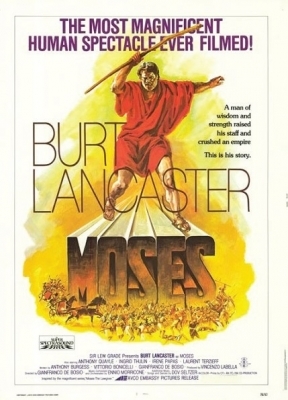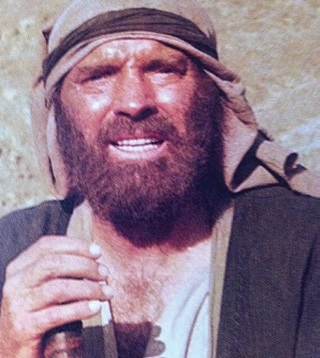When Moses Came to Eilat
Filming "Moses the Lawgiver"
Imagine a British-Italian co-production staring an American, a Swede, a Brit and a Greek, with mostly Israeli supporting cast and a mixed Italian-Israeli and all-sorts crew, stranded in Eilat for two months during the Yom Kippur War. That was Moses the Lawgiver, an ITC/RAI six-part TV mini-series later whittled down to a 141-minute film version.
After a month of volunteering in Jerusalem, I moved back to Eilat at the end of November 1973. My friend Ruth joined me two weeks later. There was no work and no prospects here either, but she picked up a rumor that a film company was looking for extras: all we had to do was show up at the Peace Café, a beatnik hangout, at 4:30am and sign up. The wages were cigarette money and a bagged lunch - which is how we wound up as extras on Moses the Lawgiver.
We were up at the crack of dawn on a December morning, had coffee and walked to the collection point. About 70 people showed up. Given that nearly all able-bodied men in Israel were on active military reserve duty at the time, the film company was scraping the bottom of the manpower barrel.
At 5am, three Egged buses (like the one at the Eilat Museum) rolled up, and we were off. Except in full daylight the desert is COLD in winter; there was no heating, but we were relatively warm in an enclosed space out of the wind. Then the buses turned off the Arava road to reach the location and desert dust came billowing up through the wooden floorboards.
We were deposited, already dusted, next to a barn-like tent where we were ordered to undress, leave our modern effects behind, and had three frantic Italian dressers costume us in "biblical" schmattes: coarse purple-brown cotton robes and mantles stinking of the dyes used on them. The footwear was a real pain: thin leather wrap-arounds that hurt to walk in.
Then we were directed to a makeup bus - only the electric generator had started up and we all made a beeline for the exhaust pipe to get warm; sleepy hairdressers had to peel us off to give the women and some men biblical hair styles tied back with more strips of smelly cloth. By 6:30 some 50-60 extras had been suitably "biblified" and the Bedouin contingent began arriving with strings of camels and herds of goats. Then we tried to find a place out of the wind and sat down to await the rest of the crew, who never showed up before 8am.
By 9am we began to warm up. As soon as the crew sorted themselves out, they sorted us for work on either "Base" or "Parallel," because there were two film crews operating at the same time. Between takes we learned that the Yom Kippur War had stranded the production company for two months in Eilat, and they were trying to make up for lost time. That first morning we wound up on Base for a crowd scene: Aharon the Priest blessing the Twelve Tribes. We were herded over to a spot where an assistant-assistant-assistant director spread us out to make us look like a crowd from a particular camera angle.
This was my first sight of the formation called Amram's Pillars, and it was well worth the trip. Not as high as Solomon's Pillars, Amram's Pillars are nonetheless more majestic: three pillars of Nubian sandstone in delicate shades of purple and white that rise up from the canyon floor.
In the first scene Aharon dedicates a kid before blessing the tribes as "the people" look reverently on. I recognized the actor playing Aharon but couldn't place him. The kid bleated its head off as it was raised and lowered by its legs for each take, watched closely by its Bedouin owner; between takes "Aharon" would reach out his hand to calm it, and the penny dropped: priest > cardinal > Anthony Quayle, nominated for an Academy Award for his role in Anne of the Thousand Days.
Finally, the kid was "sacrificed" and blessing began by drawing a stripe of fake-blood on the leaders' foreheads. For some reason the scene was shot without sound. The film rolled and Quayle began the blessing as he turned his back to the camera: "Reuben, Simon, Good Luck, Success, you look like a horse..." facing the camera, I quickly covered my face with the biblical schmatte, turned sideways and choked, so as not ruin the shot by laughing out loud.
Quayle was quiet and unassuming, arriving each morning on time in his biblical robes – with leather briefcase in hand and pipe in mouth.
Between takes we recognized other familiar faces: Yehuda Banai of the Banai entertainment dynasty, and legendary Shmuel Rodensky of Tevye's Daughters, Yiddish and Hebrew theater fame. One of Dathan's henchmen was a huge guy who loved to laugh: Paul L. Smith. He would go on to play villains in Midnight Express and Dune.
Our fellow extras were a mixed bag of beatniks, Bedouins, and a few characters like us whom the war had stranded without jobs, and curious locals coming to see what it was all about. There was even a tourist family with children who were in great demand for close-ups.
The first name we learned was Marco Antonio. He was the assistant to the assistant director whose job was to call for more takes and shout, "Motore!" (action). His directing strategy seemed to be to give the actors a general idea of what he wanted, then keep shooting take after take to get it, as many as ten takes at a time. Shooting continued as long as there was light.
After about the sixth take of the scene someone yelled, "Cut!" and one of the camels standing behind us gave a prolonged Bronx cheer. Ruth turned around to look at it, shaking her head. "Nowadays even the camels are film critics!" she commented, eliciting a smile from Rodensky, resting on a boulder nearby.
Around 1pm, actors and production crew were mini-vanned off to lunch somewhere and another mini-van arrived with sandwiches and beverage pouches which were the extras' lunch. With the sun on high it was now comfortably warm, so we spread out and relaxed.
From 2:30 the routine of hurry-up-and-slow-down continued; some scenes with Irene Papas, sitting in the mouth of a tent and looking sullen, were shot until about 5pm, when the light was gone at the base of the pillars and it was cold again. We were finally let loose to find our clothing in the pile, see if anything had been stolen and get dressed before being bused back to Eilat.
That evening I crocheted net shoulder pouches for Ruth and me to hide under our costumes. By the second day we were well up to speed: rolling our pants up to the knees to hide them under the long sack dresses (desert gravel is not comfortable to sit on), money and cigarettes safely pouched, and low sneakers disappearing under biblical footwear and rags. we would "slide-past" the makeup-bus - we really didn't want to share whatever "cooties" were on those combs.
On the third day, Ken Globus, directing on Parallel, collared a handful of extras including Ruth. At lunch time she suggested I join her, and from then on we were on Parallel as often as possible. The difference between the two locations was night and day.
Base was an Italian operation with a few Israeli grips who filmed all the important scenes. Parallel was an Israeli crew headed by Ken Globus, whose job was to film the establishing shots, the short scenes that connect one major scene to another or provide more visual information such as people gathering, walking, moving through the desert, listening to someone, nodding or shaking their heads and emoting close-ups.
But ITC had sent someone to find out what was going on with their joint production, and that was James Hill, veteran British director of Born Free. So while Ken was nominally in charge, Hill was actually directing – which was nothing less than a master class in the art of direction. The camera shot would be set up, extras told what the scene was about, what action / expressions were needed followed by one or two dry runs, a third to fine-tune minor points, and the camera rolled. We never needed more than three takes of anything. Between camera set-ups we could lie down, nap, smoke, talk, read - the atmosphere was relaxed, with an amazing amount of work accomplished in short order.
We could not escape the big crowd scenes on Base. One was the dedication of the Golden Calf, which stood on a stone plinth in the middle of a little valley. Quayle stood beside it declaiming: "This image is not God... an image of loving strength: its head the sun, its forehead the moon, its limbs the four corners of the universe." Quayle was so accomplished actor that even after the seventh take of this long, involved scene he had pulled us into it, like the audience in a theater. When we were being set up for yet another take, one of the extras relieved our tired frustrations by yelling out "Motore!" in high falsetto, cracking us up - including Qayle - and enraging Marco Antonio, who wanted to squeeze in three more takes.
Another memorable incident was Moses' departure for Mount Sinai. Late in the day, when it was getting cold again, we extras were artfully spread out on an uneven slope to simulate a multitude. The slope was shale. Burt Lancaster as Moses, accompanied by Aharon Ipalé as Joshua, were to climb through the crowd up the slope. The camera rolled. Lancaster started his climb, Ipalé behind him. The two climbed steadily to just below the top of the ridge where even the goat and ibex tracks disappeared; there was no going higher. Lancaster slipped on the shale and hunkered down so as not to fall or slide. He waited. We waited. We could still hear the camera whirring. He waited. After half a minute he turned around and yelled down the slope over his shoulder: "Cut the f*****g film, you sonofabitch!"
We cheered: he had expressed the sentiment we couldn't without losing our jobs. Lancaster marched back down the slope, grinning from ear to ear, past director, camera and crew and straight into his trailer. We took this as a sign that filming was over for the day but assistants yelled at us to stay in our places. We stood around for another few minutes before it became clear that Lancaster was not going up that slope again, and we were sent to get dressed.
Filming continued to the end of February 1974. Somehow or other Rafi Nelson got hold of the Golden Calf: for years it was a fixture atop the ridge overlooking Nelson's Village at Taba.
But I'll leave the last word to Ruth: "I remember that filming to be very entertaining, except having to get up in the dark purely to be out in the cold desert with ill-tempered camels and horny Italians."
From Wikipedia
Moses the Lawgiver was a 1974, 6-part TV mini-series directed by Gianfranco De Bosio and James H. Hill, starring Burt Lancaster, Anthony Quayle, Ingrid Thulin and Irene Papas, with screenplay by Vittorio Bonicelli and Anthony Burgess, and music by Ennio Morricone.
Shooting took place in Rome and on location in Morocco and Israel in 1973–74.









Comments